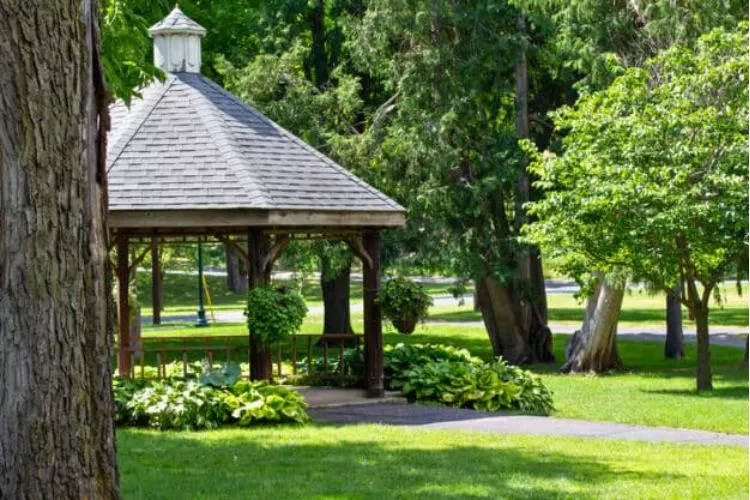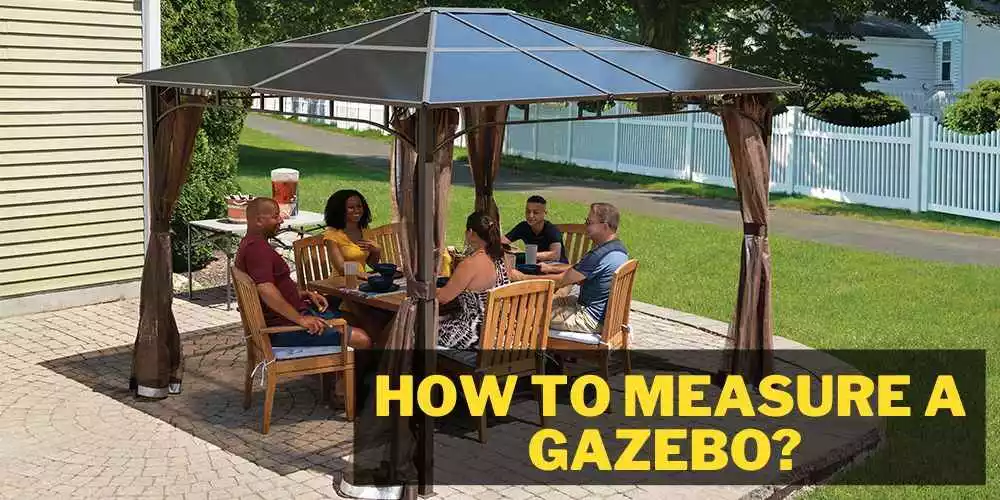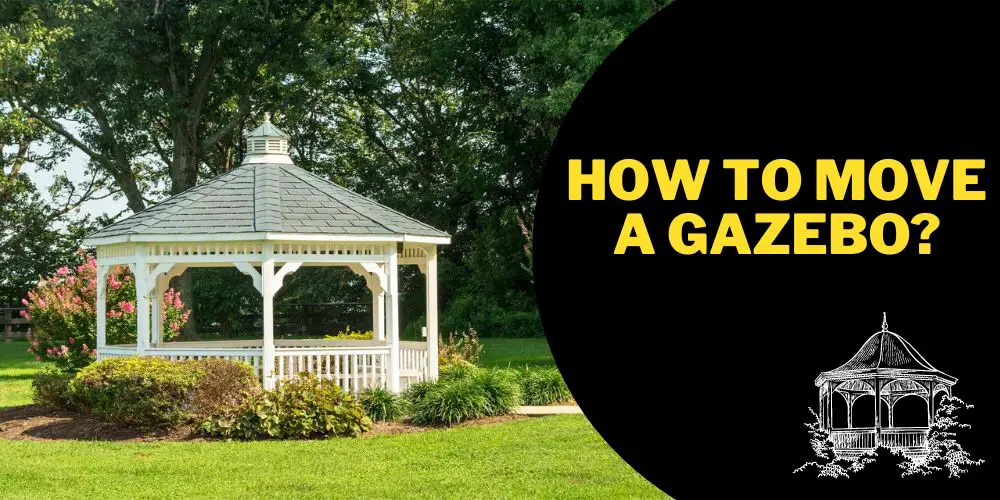Choosing the right orientation for your gazebo can truly enhance its usability and aesthetic appeal. But you might be wondering, “Which way should a gazebo face?”.
This question hinges on several considerations, including sunlight exposure, prevailing winds, view, and privacy.
In this article, we delve into these factors to guide you in determining the optimal direction for your gazebo, so it can not only harmonize with your landscape but also provide optimal comfort and satisfaction.

Which Way Should a Gazebo Face? (Determining the Optimal Orientation)
The optimal direction for your gazebo primarily depends on your local climate and the primary time of day you’ll use it.
For those in hot climates aiming to enjoy cooler mornings or afternoons, facing your gazebo north or east ensures it captures the gentle morning sunlight while staying cooler during hotter parts of the day.
Conversely, if you’re in cooler climates and prefer warmth, a south-facing direction might be best to maximize sun exposure throughout the day.
Additionally, consider prevailing winds for comfort, and position the gazebo to offer the best views of your garden or landscape.
Privacy is another crucial factor; ensure the gazebo’s orientation shields you from neighbors’ views if that is a concern.
Balancing these elements—sunlight, wind, views, and privacy—will guide you to the ideal placement for your gazebo, making it a perfect retreat.

1. Analyzing the Sun’s Path
Understanding the sun’s daily journey across the sky is crucial when positioning your gazebo. The sun’s position at different times can impact your gazebo’s temperature, lighting, and overall ambiance.
In the northern hemisphere, the sun rises in the east and sets in the west, moving across the southern part of the sky. Conversely, in the southern hemisphere, the sun travels through the northern part of the sky.
If you’re a morning person and enjoy the early light, orient your gazebo entrance towards the east. This way, your gazebo will bathe in the warm morning sunlight, perfect for a serene breakfast spot. On the other hand, if you want a gazebo that catches the afternoon glow and sunset, facing it west would be an ideal choice.
There are several ways to track the sun’s path. Online tools like SunCalc provide an interactive sun trajectory map for your specific location for a quick general idea. But nothing beats a physical observation. Spend a day noting the sun’s position at different times, specifically during the periods when you’ll be using the gazebo the most.
2. Assessing Wind Patterns
Wind patterns can significantly influence your gazebo’s comfort and longevity. Strong winds can damage your gazebo over time and create an unpleasant or chilly environment.
Start by identifying the prevailing wind direction in your area. This information is usually available from local meteorological services or online weather sites. For instance, if you live near a coast, you might experience onshore breezes during the day and offshore ones at night.
Once you know your predominant wind direction, position your gazebo to minimize exposure to these winds. You could place it near natural windbreaks like hedgerows, walls, or buildings. Alternatively, you could use an anemometer, a device that measures wind speed and direction, to precisely understand your local wind patterns.
You May Find Useful: Best Gazebo For High Winds
3. Considering the Surroundings
Your gazebo is not isolated; it’s part of a broader landscape. Hence, nearby elements like trees, buildings, and other features can substantially affect its orientation.
For instance, a large tree near your proposed gazebo site can provide welcome shade during the hot months. But it might also block views or shed leaves onto your gazebo. Similarly, a nearby building might offer wind protection and privacy but could cast long shadows or obstruct views.

You May Also Read: Best Gazebo For Winter
Incorporating Feng Shui Principles in Gazebo Placement
Incorporating Feng Shui principles into the placement of your gazebo can transform your outdoor space into a harmonious sanctuary that promotes wellbeing and positive energy flow, or Qi.
Feng Shui, an ancient Chinese art, seeks to balance the energies in any given space to ensure health and good fortune for its inhabitants.
When it comes to positioning a gazebo, several key Feng Shui concepts can be applied to enhance its beneficial impact.
Commanding Position: In Feng Shui, the commanding position is crucial for placement. Your gazebo should face the main entrance of your home but not directly align with it, creating a welcoming yet unobstructed flow of energy. This position signifies protection and oversight, allowing you to relax while overseeing your domain.
Relationship with the Elements: The five elements of Feng Shui — wood, fire, earth, metal, and water — can guide the placement and materials of your gazebo. A wood gazebo can enhance growth and creativity, especially when placed in the east for health and family or the southeast for wealth and abundance. Incorporating metal elements can foster mental clarity and reduce stress, ideal for a west-facing gazebo.
Integration with Nature: Feng Shui emphasizes harmony between human structures and natural elements. Place your gazebo where it can harness the life energy from surrounding trees, plants, and water features. However, avoid positioning it under large trees, which can create too much Yin (passive) energy, leading to stagnation.
Open and Flowing Qi: Ensure the area around your gazebo is clutter-free and well-maintained to keep Qi flowing freely. The path to your gazebo should be clear and inviting, promoting a smooth, meandering flow of energy towards this tranquil retreat.
Consideration of Shapes: Circular or octagonal gazebos are auspicious in Feng Shui, as they allow energy to circulate smoothly. Avoid sharp angles and corners, which can create Sha Qi, or attacking energy, disrupting the serene atmosphere.
By thoughtfully applying these Feng Shui principles to the placement of your gazebo, you create a space that not only elevates the aesthetics of your garden but also fosters a deeper sense of balance and peace in your outdoor sanctuary.
Frequently Asked Questions (FAQs)
What if my location experiences extreme weather conditions?
For locations with extreme weather, consider sturdy gazebo materials and designs. Orient it to mitigate exposure to prevailing winds and include built-in protection like reinforced walls or removable enclosures.
Should I consider the gazebo’s alignment with my home’s architecture?
Yes, aligning your gazebo with your home’s architecture can enhance visual harmony and impact accessibility and ease of use.
Can I adjust the orientation of a pre-built gazebo?
Adjusting the orientation of a pre-built gazebo can be challenging and may require professional assistance. It depends on the gazebo’s design and the materials used.
Are there any recommended materials or designs for sun protection?
Sun-resistant materials such as UV-protected polycarbonate roof panels or shade cloths can offer sun protection. Opt for designs with adjustable or removable walls for adaptable sun control.
How do I know which direction my gazebo is facing?
Use a compass or a smartphone’s built-in compass app. Stand in the center of the gazebo and note the direction you face when looking out from the entrance.
Conclusion:
In conclusion, determining the ideal gazebo orientation involves balancing numerous factors such as the sun path, wind patterns, views, privacy, and surroundings.
Adapting to your local climate and incorporating natural shade elements can significantly enhance your gazebo experience.
For unique situations, don’t hesitate to seek professional advice. Remember, your gazebo should be a personal haven that complements your outdoor space and lifestyle.
We hope that this guide has been helpful. You can read about similar topics here on our website. Check back again soon for more.


